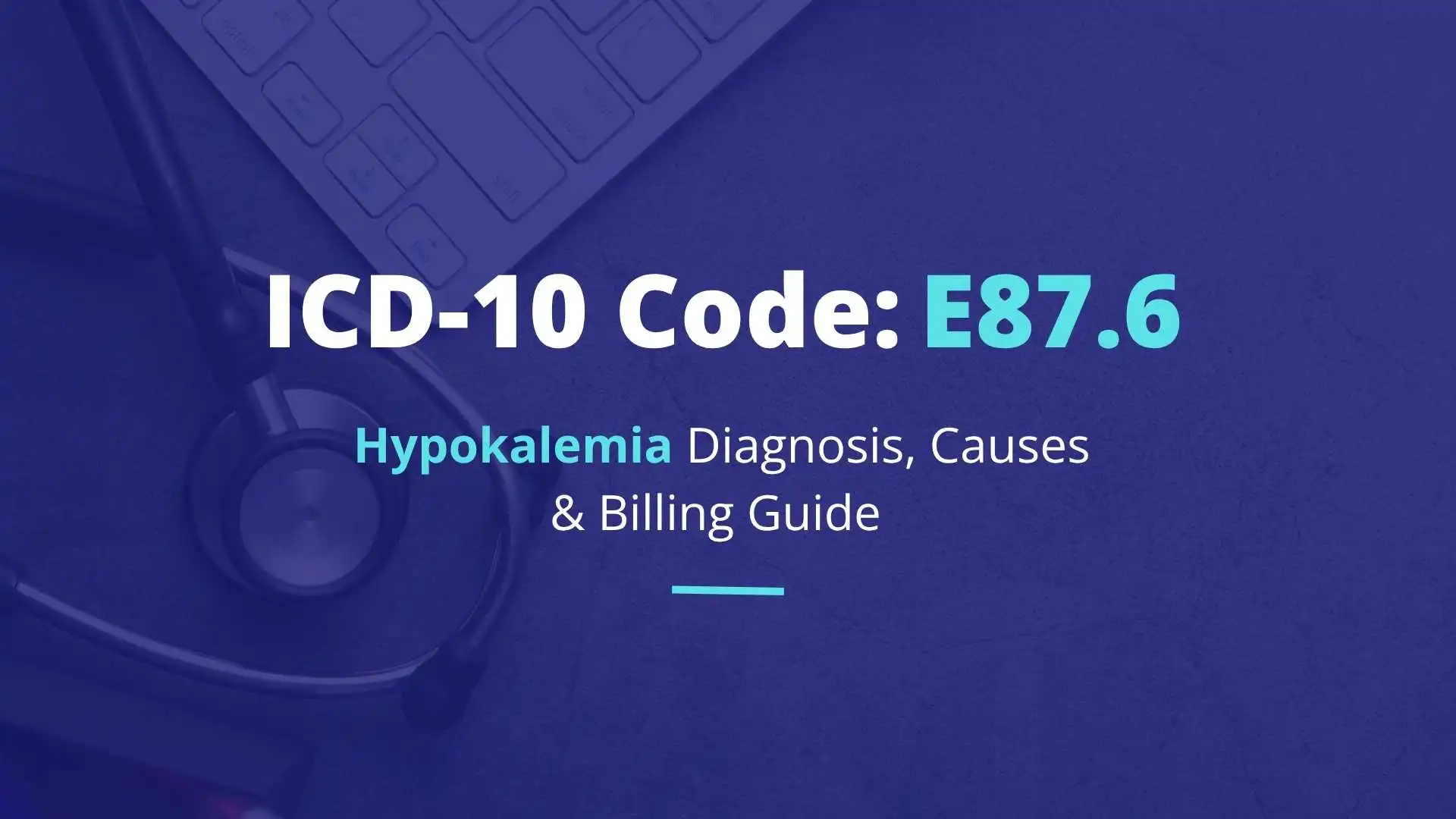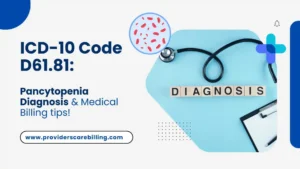One of the most significant minerals in a human body is potassium. It causes cells to act, tightens up the muscles, keeps the heart pumping freely and regularly, and regulates the whole system of fluid within the body. But sometimes the potassium level in blood can fall. This is called Hypokalemia. The level of potassium in the blood in Western medicine is recorded under a special coding system; E87.6 is the Hypokalemia ICD-10 code.
In this blog post, we will investigate the symptoms, causes, and treatments of hypokalemia. We will also discuss in detail why the use of an ICD 10 code involving potassium levels is necessary, how it differs from other related codes like hyperkalemia ICD 10 and the newly released ICD-10 code for high potassium.
Let us make it easy to understand.
What is Hypokalemia?
Hypokalemia occurs when there are too low potassium ions in the blood. Potassium is necessary for cells, nerves and muscles to function properly. If there is not enough potassium, then body activities will be less effective.
Normal blood potassium ranges from 3.5 to 5.0 mEq/L. Hypokalemia is a condition in which the K+ level drops below 3.5 mEq/L. At first, people may feel nothing as long as it is light on them. But later on, they often feel very tired and weak, dizzy or lightheaded, or even have muscle cramps and irregular heartbeats.
The ICD-10 code for hypokalemia is a method to track this condition in medical records.
What is the ICD-10 Code for Hypokalemia?
Hypokalemia ICD-10 code is E87.6, an official description of a medical coding system in worldwide use. The ICD-10 in today’s edition of medicine is International Classification of Diseases, 10th Revision.
A physician encounters a patient who has low potassium and notes E87.6 ICD-10 on records or medical claims. It helps in billing, monitoring patient care, and data collection of health.
A doctor can also write the ICD-10 code hypokalemia unspecified when the cause is not yet obvious. This continues to indicate low potassium, however, with no additional information.
Other phrases for this same issue include:
- ICD-10 for low potassium
- Low potassium ICD
- Potassium deficiency ICD 10
All of them refer to the same medical condition.
What Causes Hypokalemia?
Now you may think; why should there be low potassium in someone? The reasons are numerous and some are more serious than others.
The following are some common causes:
- Vomiting or diarrhea: When too much fluid is lost through vomiting or diarrhea, the potassium can be carried along with it.
- Diuretics (water pills): These are the drugs that are frequently prescribed for high blood pressure, which can in turn reduce the potassium.
- Lack of sufficient potassium intake: This is a rare occurrence that can occur in cases of unhealthy diets.
- Kidney issues: In case the kidneys expel excess amounts of potassium.
- Hormonal disorders: e.g., hypothyroidism during pregnancy, ICD 10, the condition that can interfere with the balance of potassium.
In addition, some conditions such as dehydration during pregnancy, ICD 10, may result in the alteration of the level of potassium, particularly, where there is vomiting or replacing body fluids.
Since electrolyte imbalances like Hypokalemia often coexist with other conditions affecting blood pressure, it’s essential to also understand how Hypotension is diagnosed and billed. Explore the ICD-10 Code I95.9 for Hypotension here.
What are the Symptoms of Hypokalemia?
Some people with low potassium experience no form of pain. However, when it further drops, then symptoms begin to appear. Those can include:
- Weakness of muscles or cramps
- Being tired or feeling fatigued
- Irregular heartbeats
- Numbness
- Shortness of breath
Doctors can also test low bicarbonate ICD 10 and this can be associated with acid-base imbalances when the potassium is low.
Diagnosing Hypokalemia
Hypokalemia is most often diagnosed in a blood test prescribed by doctors. The test helps in assessing a potassium level in the blood. Depending on the level, the dx code hypokalemia may be used in the chart by the doctor in case of low level.
If other problems are found, too — like too much acid or fluid loss — the doctor may use multiple ICD-10 codes, such as:
- ICD-10 code for potassium level
- ICD-10 thrombocytopenic disorder (if low platelets are also present)
- Low bicarbonate ICD 10
This helps give a clear picture of what occurs in the human body.
Hypokalemia vs Hyperkalemia
Hypokalemia indicates low levels of potassium and hyperkalemia shows high potassium concentration. The hyperkalemia ICD-10 code is E87.5.
It is better to learn the difference between them because they both may influence the heart and muscles. However, they require various treatments. Too much potassium is also not good for health, especially for patients with kidney issues.
In case a patient exhibits high potassium, then the ICD-10 code for high potassium is adopted instead. It is therefore just a question of getting the right code to the right condition.
How Is Hypokalemia Treated?
The positive thing is that sometimes, hypokalemia is easily rectified, particularly when it is diagnosed early. Depending on the level of its deficiency and the cause of the potassium level being low, treatment is possible.
The typical way of treating it is as follows:
- Using potassium supplements
- Not taking medicine that eliminates potassium.
- Eating bananas, oranges, potatoes, and spinach, as they have high potassium content
- Regular checking, especiallyimportant when the patient is suffering from some other diseases.
Physicians recheck the blood levels quite frequently to ensure that the treatment is working.
Why Medical Coding Matters?
You may wonder why codes like E87.6 ICD-10 are so important. These codes do more than just label a condition. They help in:
- Keeping clear and organized patient records
- Helping insurance companies understand what treatment is needed
- Supporting research on how common certain conditions are
- Ensuring that the appropriate care is offered.
Therefore when you go incidentally in the study of ICD 10 for low potassium, it is not just a code but a component of a major machine that aids in smooth running of healthcare.
Related Conditions and Codes
The following are some of ICD-10 codes, which can be used in conjunction with E87.6:
- Hypothyroidism during pregnancy, ICD 10 (O99.280) -May affect metabolism and the balance of minerals.
- Pregnancy-related dehydration ICD 10 (O26.891) – In some cases when the loss of fluid changes the levels of potassium.
- ICD-10 thrombocytopenic disorder (D69.6) – There can be low counts of platelets in the presence of other imbalance
- Low bicarbonate ICD 10 (E87.2) – Acid-base imbalance is indicated.
These codes can further create a complete image of the health of an individual.
Final Thoughts!
So now you know- the Hypokalemia ICD-10 code is E87.6 and is utilized to define the low potassium concentration in the blood. Doctors manage this type of common condition on a daily basis. Regardless of the reason behind it, low potassium should be taken seriously whether it is the fault of medicines, diet, or any other disease.
ICD-10 code of hypokalemia enables nurses and doctors to be organized and deal with the problem properly. It also assists insurance companies and researchers to understand the frequency at which the problem occurs.
You should never hesitate to have a discussion with your doctor when you feel dizzy, weak or tired without an obvious cause. Your level of potassium can be checked by a simple blood test. In case it is low, there is nothing to worry about and it is curable.
When you come across a term such as ICD-10 hypokalemia, dc code hypokalemia or ICD-10 low potassium, you will clearly understand what these words mean.




